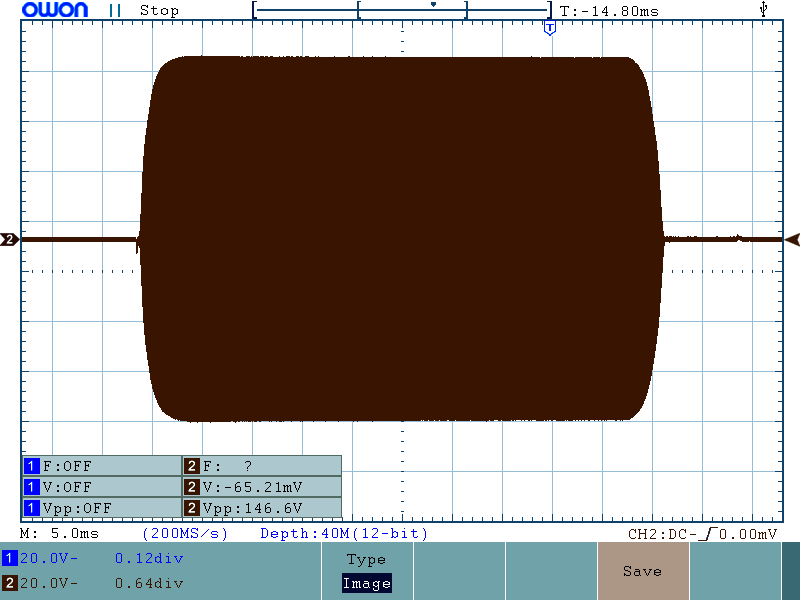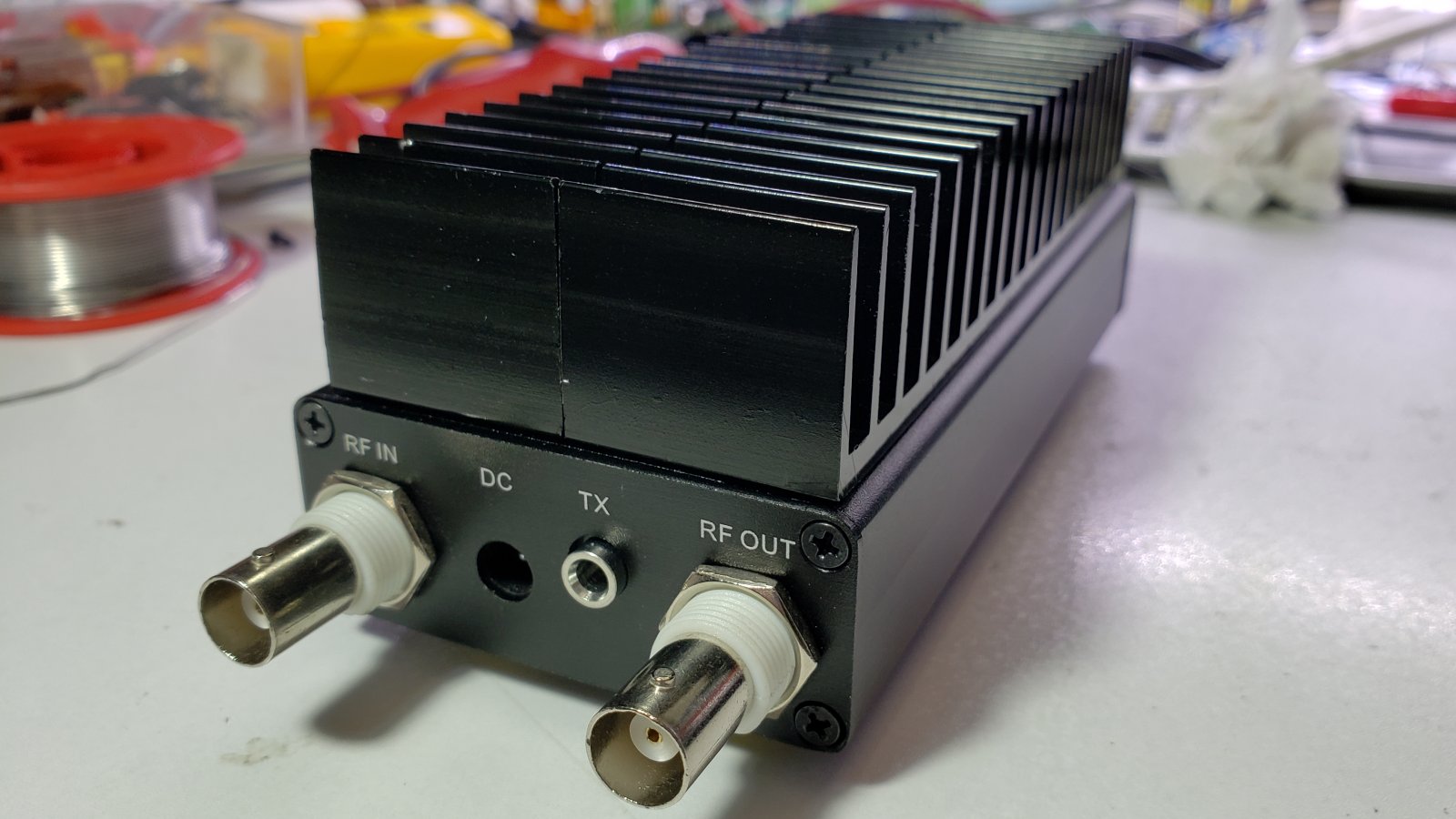Another long gap in newsletters I'm afraid... anyway I hope this will serve to keep you up to date, and it will at least allow me to wish you all a very MERRY CHRISTMAS and a HAPPY NEW YEAR!
1. New product: 50W PA kit for QCX
2. QCX firmware updates T1.01,T 1.02 and T1.03
3. Clock kit firmware update c1.03
4. QRP Labs at Friedrichshafen HAM Radio, 21-23rd June
5. QRP Labs Hans G0UPL receives Homebrew Heroes 2019 award
6. Veron "Day of The Amateur" hamfest in Netherlands
7. QSX project progress update
8. QCX Si5351A Phase noise measurement
9. QCX Transceiver review in QST August 2019 and QLG1 GPS Receiver review in QST September 2019
10. A guide to your first CW QSO!
11. Andy RW9RN in CW WW DX CW Contest with the QCX-20
12. Social media, Feedback, unsubscribing
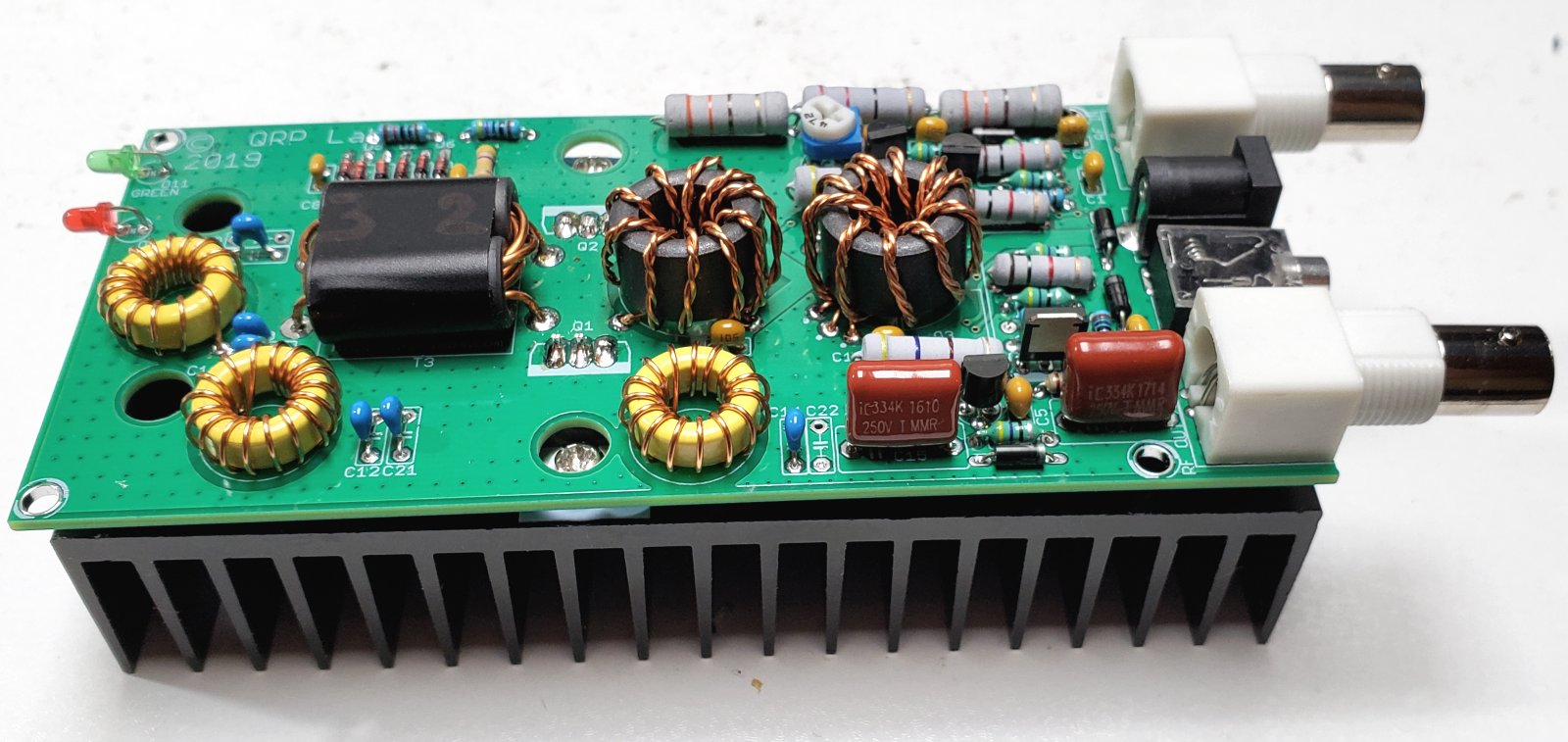 1. New product: 50W PA kit for QCX
1. New product: 50W PA kit for QCX
We are pleased to announce a new kit in the QRP Labs line-up. This is a 50W PA kit for the QCX 5W CW transceiver kit. See http://qrp-labs.com/50wpa . The price is $29.50 (approx £22 or 26€) which includes the PCB, all components and connectors, and two large black anodized aluminium heatsinks (as pictured, right). The amplifier produces up to 50W power with full break-in (QSK), with 20V 5A supply. At 13.8V supply on 40m CW, the measured power output is over 25W.
The QCX transceiver continues to be amazingly popular and we have now sold nearly 9,000 since the launch in August 2017. This addition to the QCX produces a powerful, high performance CW transceiver which will level the playing field, putting you in the same power class as the majority of CW operators on air.
A beautiful enclosure for it is also available, price $16 (approx £12 or 14€), see http://qrp-labs.com/50wpabox . It is made from black anodized extruded aluminium with front and rear panels drilled and printed to match the 50W PA.
A key feature of the kit is fast solid-state transmit/receive switching (relays!) - which allows full break-in (QSK) operation using the QCX. See the chart below showing output power vs supply voltage, and the oscilloscope screenshot showing a single 24-wpm Morse "dit" with very nice RF envelope shape.
The kit can be built for 40, 30 or 20m bands, which covers 90% of QCX kits. It can also be built for other bands if you supply your own Low Pass Filter components. Multi-band would be possible if you connect your own switched external Low Pass Filters.
Please refer to the FAQ on the 50W PA page http://qrp-labs.com/50wpa if you have any questions. The 68-page manual is very detailed making construction un-daunting, and the manual also also includes a substantial section detailing the circuit theory.
Despite our dedication to QRP (5W and under), there are occasions when a bit more power is needed, and this kit provides it. For example, you want to QSO a particular station on a sked at a particular date and time; or when conditions are poor, or you want to work particular DX... any number of reasons.
During the summer of 2019 the 40m version of this amplifier was tested extensively here in QTH KM46, with well over 500 QSOs in the log. Despite the poor band conditions and my very mediocre antenna and location, QSOs ranged from New Zealand and Japan in the East, to US in the West; Finland in the North, down to Saudi Arabia and everywhere in between. (500+ real QSOs averaging 10 minutes, not contest exchanges). During QSOs I estimate around 90% of correspondents are using power in the 50-100W range, the remaining 10% operate with higher power than that or a few of them, with QRP (5W and below). This 50W PA kit puts you and your QCX on a level playing field with the majority of CW operators on the bands.
So pimp your station, pump up the watts... have some fun with a new project... the 50W PA kit http://qrp-labs.com/50wpa
2. QCX firmware updates T1.01, T1.02 and T1.03
 Several firmware versions were produced in October-December 2019 making the famous QCX 5W CW transceiver even better! The current latest firmware is version T1.03.
Several firmware versions were produced in October-December 2019 making the famous QCX 5W CW transceiver even better! The current latest firmware is version T1.03.
If you have an AVR programmer you can update your existing firmware chip to the new version, by downloading the firmware file (T1.03.hex) from the QRP Labs groups.io discussion forum https://groups.io/g/qrplabs files area. If you are not familiar with the process, please make use of one of the numerous tutorials are also available there, explaining how to do it. Alternatively if you wish to make use of the new features and would like to purchase a ready-programmed chip, these are available in the QRP Labs shop firmware section http://shop.qrp-labs.com/firmware/qcxchip.
The full list of firmware changes is here: http://qrp-labs.com/qcx/qcxfirmware.html. There were several bug fixes and lots of enhancements. My favourite highlights are:
- CAT control interface permitting the QCX to be remotely controlled, by logging software etc. The supported command set is a subset of the TS-480 with several changes; please refer to the latest manual at the QCX page for full details.
- On-screen real-time clock available, which can be set by connecting the QLG1 GPS module temporarily, at any time
- Complete elimination of the "woodpecker", faint clicking in the audio (usually only audible when no antenna connected) when the S-meter is enabled or the screen updates for any reason. The QCX is now completely quiet! No clicking when the display updates!
- Automatic practice mode, if you connect a GPS without being in the beacon or alignment menus; this protects the PA from damage
- Customize your QCX with your own Splash screen message, that can replace the default one
- Elimination of clicks when the sidetone starts and finishes, at volumes less than maximum
- Operating improvements: allow adjustment of RIT and Speed display while operating the radio normally; this is very nice when operating a particular frequency, you can leave the rotary encoder adjustment linked to the displayed RIT, so that turning the rotary encoder adjusts RIT while you can continue to operate. It's very useful in practice!
- Bug fix to the long-standing quirks of Iambic mode A; it now works exactly like the original Kurtis Iambic keyer chip
- Bug fix to the long-standing "disappearing S-meter" issue
3. Clock kit firmware update c1.03
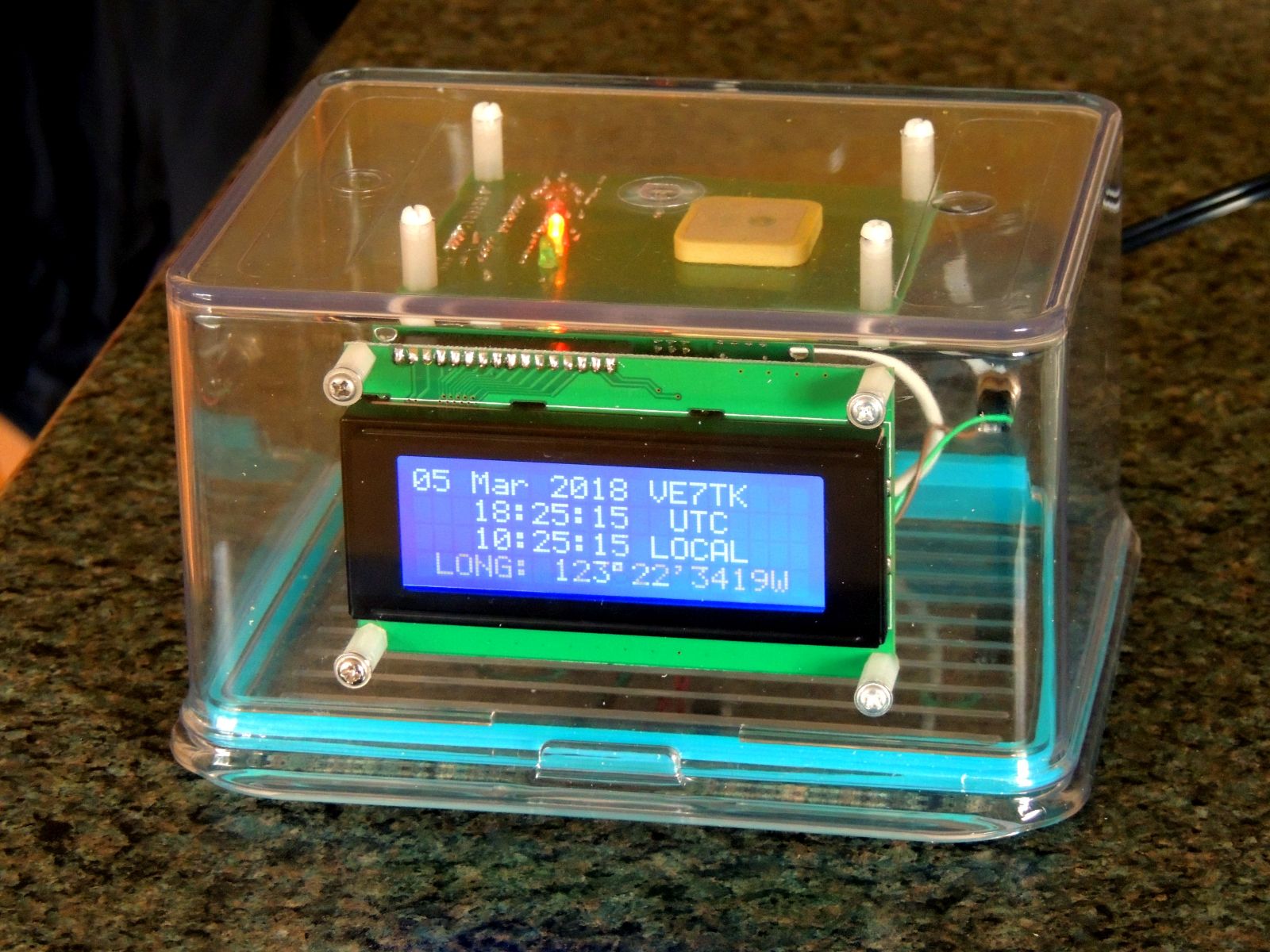 A firmware update to the clock kit was produced in September 2019. The clock kit is priced only $18 and is a popular and simple to construct kit, which can be used standalone but is normally used in conjunction with the QRP Labs QLG1 GPS receiver module kit. The display can be entirely customized to your wishes, including scrolling different items on each line, when there is more information than the available 16 x 02 character display area. The clock is also compatible with 4-line display modules which you can connect in place of the supplied 2-line 16-character module. Text from the GPS is embedded in whatever you configure for the display, by using tags for example #LT for latitude. The 4-line clock in this example was built by Rick VE7TK.
A firmware update to the clock kit was produced in September 2019. The clock kit is priced only $18 and is a popular and simple to construct kit, which can be used standalone but is normally used in conjunction with the QRP Labs QLG1 GPS receiver module kit. The display can be entirely customized to your wishes, including scrolling different items on each line, when there is more information than the available 16 x 02 character display area. The clock is also compatible with 4-line display modules which you can connect in place of the supplied 2-line 16-character module. Text from the GPS is embedded in whatever you configure for the display, by using tags for example #LT for latitude. The 4-line clock in this example was built by Rick VE7TK.
The main features in the update are:
- Addition of local and greenwich Sidereal time - refer to https://en.wikipedi0.org/wiki/Sidereal_time for more information on Sidereal time. The computation uses the latitude, longitude, date and time parsed from the GPS serial data stream.
- Additional tag #AF for altitude in feet
- Local and UT day of the week tags E.g. "Sat" or "Saturday"
- Bug fix to the long-standing local-date problem
If you have an AVR programmer you can update your existing firmware chip to the new version, by downloading the firmware file (c1.03b.hex) from the QRP Labs groups.io discussion forum https://groups.io/g/qrplabs files area. If you are not familiar with the process, please make use of one of the numerous tutorials are also available there, explaining how to do it. Alternatively if you wish to make use of the new features and would like to purchase a ready-programmed chip, these are available in the QRP Labs shop firmware section http://shop.qrp-labs.com/firmware/clockchip.
4. QRP Labs at Friedrichshafen HAM Radio, 21-23rd June
QRP Labs exhibited again at the HAM Radio hamfest in Friedrichshafen, Germany on 21, 22 and 23rd June. The booth is in the main A1 exhibition hall was very busy for the whole 3-days of the event. A good selection of most of the QRP Labs range of kits were on hand to purchase and many people just stopped by for a nice chat.
Many thanks to Hannes DL9SCO for the extra nice hospitality and later, visiting Hajo DL1SDZ on my way home.
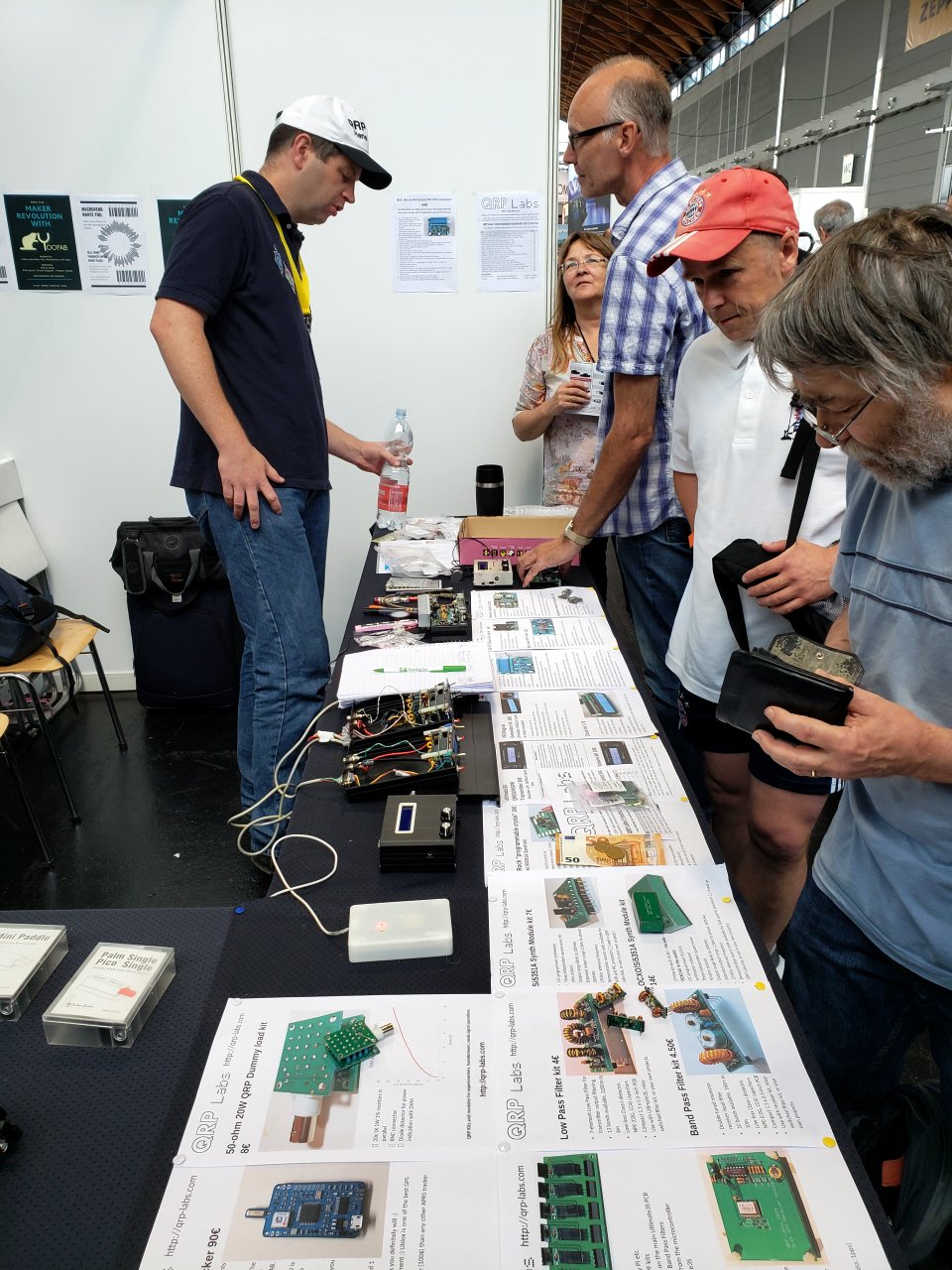

 5. QRP Labs Hans G0UPL receives Homebrew Heroes 2019 award
5. QRP Labs Hans G0UPL receives Homebrew Heroes 2019 award
It was my great honour to be awarded the Homebrew Heroes 2019 award in October 2019, "for noted excellence in the realm of electronic homebrew activity". This is a new annual award, and so it was even more amazing to be the very FIRST, inaugural recipient of the award!
There's a formal video presentation of the award on the Homebrew Heroes website here: https://homebrewheroes.org/index.php/heroes/
In the photo (right), I am wearing one of the two beautiful Homebrew Hero award embroidered T-shirts and the Homebrew Hero award baseball cap, and holding the wooden plaque!
The award is also sponsored by a number of corporate prize donors, I am very grateful to these for their generous prizes. I now have a pile of new toys to play with here in the lab, which will be fun, educational and very useful in the development of new QRP Labs kits and my personal projects.
- Siglent donated their 200MHz SDS-1202X-E Digital Storage Oscilloscope. This high performance modern oscilloscope now sees daily use on my workbench. An recent example was in the diagnosis of a 50W PA failure (prototype of the new 50W PA kit launched on 12-Dec-2019), and documented here http://qrp-labs.com/qcx/qcxmods/ptt.html showing how the 'scope was useful. More info on the 'scope: https://siglentna.com/product/sds1202x-e/
- Digilent Analog Discovery 2 module and a big box of accessories. The Analog Discovery 2 is a test and logging device that with software running on a PC, provides a large array of test equipment in one small unit. More info: https://analogdiscovery.com/ - I have not yet had time to experiment with it.
- Heil Sound donated their high quality Pro Set 3 stereo headphones, a microphone and other accessories. I have already been using the headphones with my QCX transceiver enjoying 40m CW and they certainly sound very nice indeed. I love the way they block out surrounding noise such as power supply fan noise and let me focus on the band. Heil Sound web page.
- MFJ sent their Graphical Antenna Analyzer model MFJ-225, I understand from the documentation it has many functions but so far I have only explored the basic antenna analyzer function. Connected to my Spiderbeam UL-404 off-center-fed-dipole that I currently use for all my operating, it gave SWR curves closely in-line with the manufacturer's specification and my own measurements using a much lower specification Arduino-based antenna analyzer back in January this year. More on the MFJ-225: https://www.mfjenterprises.com/Product.php?productid=MFJ-225
- Ham Radio Workbench will be sending their Benchduino board and accessories, which apparently is a perfect partner to the Digilent Analog Discovery 2 module. See https://www.hamradioworkbench.com/benchduino.html
Many thanks again, to the corporate prize sponsors, and of course, to the Homebrew Heroes award organizers for the amazing honour!
6. Veron "Day of The Amateur" hamfest in Netherlands
This year I was privileged to attend the Veron Day of the Amateur convention at Zwolle, Netherlands on 2nd November, and operate a QRP Labs stand there. It was the first time I have been to this event. It is clear that amateur radio is thriving and active in Netherlands!
Many thanks to Geert PA7ZEE for the invitation and hospitality; Geert and his XYL were absolutely perfect hosts from start to finish and I thoroughly enjoyed every single minute of my short 2-day visit to Netherlands.
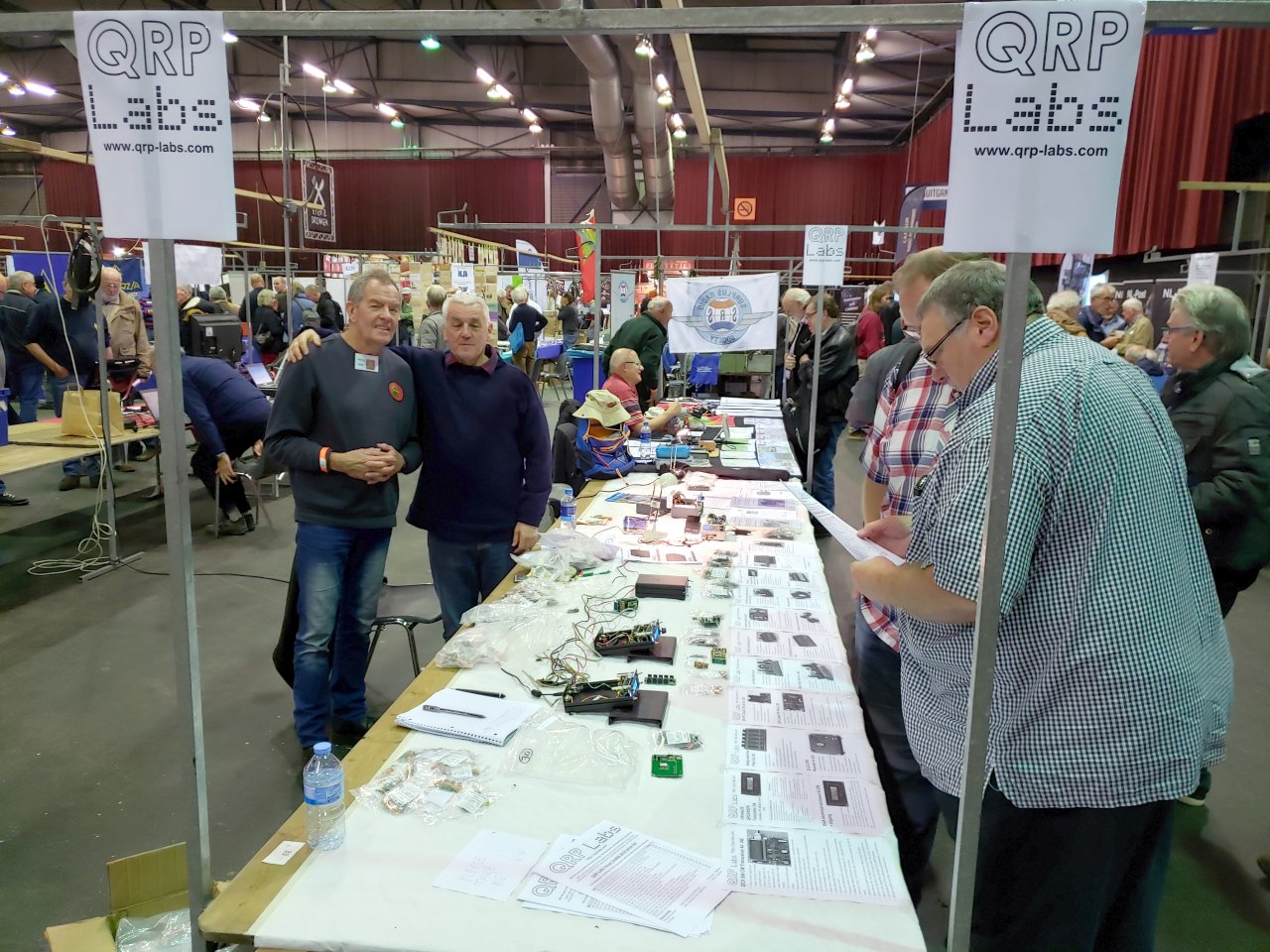
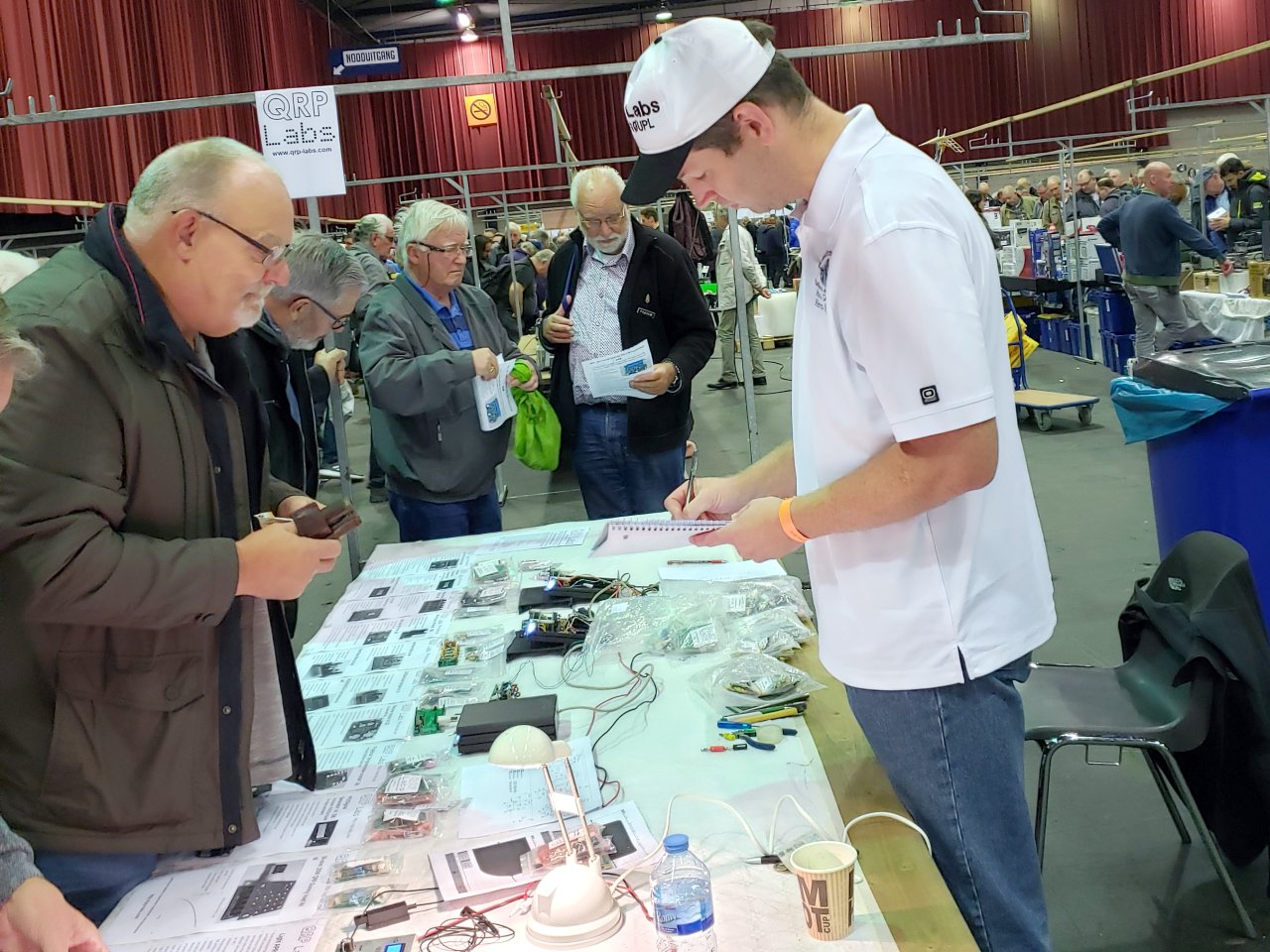
7. QSX project progress update
A significant number of people are wondering about the long awaited QSX all-band all-mode transceiver kit availability date. This transceiver will pack huge performance and features into a humble package with a very low price. It will set new standards in the features and performance to price ratio. Whilst there is still no firm availability date, I wrote a large post to the QRP Labs groups.io discussion forum, which explains the current situation and the reasons it has taken longer than expected, but please have patience, the project is alive and well and WILL BE FINISHED in due course. See https://groups.io/g/QRPLabs/message/40900
 8. QCX Si5351A Phase noise measurement
8. QCX Si5351A Phase noise measurement
Following lengthy correspondence with Kevin ZL1UJG on the topic of measuring (and improving) the Si5351A phase noise, I developed my own measurement equipment here for phase noise. I was particularly interested to measure the phase noise performance of the QCX CW transceiver. I had previously assumed complex and expensive equipment would be required for measuring phase noise, but was pleasantly surprised that it is not at all as bad as I had anticipated.
This experiment and the results are documented in detail here: http://qrp-labs.com/qcx/phasenoise.html. It's a very interesting and educational read.
Once the basic test equipment had been built and evaluated, several measurement runs were completed of the QCX in various different scenarios; both the raw output at the pin of the Si5351A chip and the overall transmitter output. The scenarios cover attempts to provide supply line filtering such that the Si5351A chip gets a cleaner supply voltage, and also decoupling the output (AC coupling) with different loading.
The overall main conclusions were:
- Phase noise of the QCX transceiver is GOOD and does not seem possible to improve by any means; this indicates that the phase noise is limited by the internal loop characteristics of the PLL in the Si5351A Synthesizer chip
- Measurement techniques and results were compared with Kevin ZL1UJG and similar conclusions were reached by Kevin. The calculations also agree with my spectrum analyzer manual and the descriptions of OE3HKL at http://www.oe3hkl.com/hf-measurements/oscillator-sb-noise/vfo-sb-noise-5-202-khz-qf.html. The transmitter output results match those of measured by the ARRL in the QST August 2019 review which you can read here: http://www.qrp-labs.com/images/qcx/ARRLAug2019.pdf
- Phase noise of the Si5351A is significantly degraded by using a low impedance load; this can be partially remediated by using a DC-blocking capacitorThe QCX phase noise performance exceeds that of two other transceivers known to use the Si5351A Synthesizer and reported by ARRL reviews: The Elecraft KX2 and HF Signals uBITX.
9. QCX Transceiver review in QST August 2019 and QLG1 GPS Receiver review in QST September 2019
The QCX CW Transceiver was reviewed by the ARRL in the August 2019 QST edition including measurements by the ARRL laboratory. The review is very favourable. The review is reproduced with the permission of the ARRL on the QCX web page see http://qrp-labs.com/qcx
The September issue of QST included a further review of the QLG1 GPS Receiver kit and using it with the QCX to operate the QCX's WSPR beacon mode. This review is reproduced with the permission of the ARRL on the QLG1 GPS receiver kit page see http://qrp-labs.com/qlg1
10. A guide to your first CW QSO!
 Getting on air with CW can be daunting. It is not just about being able to copy the Morse alphabet, but also how to deal with conventional QSO procedures, including abbreviations such as the Q-code and other common abbreviations used by CW operators on air. It has been my great honour to have been the QSO partner of several first-time CW QSOs, arranged in advance; one of these was George SV2SBE on Thursday 26-Sep-2019. We used 40m CW and the distance was perfect for us to operate in mid-afternoon with good strong signals both ways.
Getting on air with CW can be daunting. It is not just about being able to copy the Morse alphabet, but also how to deal with conventional QSO procedures, including abbreviations such as the Q-code and other common abbreviations used by CW operators on air. It has been my great honour to have been the QSO partner of several first-time CW QSOs, arranged in advance; one of these was George SV2SBE on Thursday 26-Sep-2019. We used 40m CW and the distance was perfect for us to operate in mid-afternoon with good strong signals both ways.
In my opinion, getting on air and USING CW is the best way to gain proficiency. As soon as you know the Morse alphabet, get started! With this in mind I wrote a guide to your first CW QSO, that explains the commonly used Q-codes and abbreviations, and gives a template for a QSO to explain the common procedure. See: http://qrp-labs.com/qcx/cwqso.html
In the photograph (right), this is my 40m QCX with the 50W PA kit prototype built in the same enclosure.
The following day I enjoyed another QSO with George, and this was a first for me too: the first time I had operated a QSO with a paddle, rather than the various straight keys I have always used! The paddle in question is the Palm Radio picopaddle, which is pictured on the front of the QCX CW Transceiver manual. Now this key sees frequent actual use, not just as a photo model!
11. Andy RW9RN in CW WW DX CW Contest with the QCX-20
Big congratulations to Andy RW9RN for an excellent result in the CQ WW DX CW contest with his QCX-20! In the QRP 20m category, Andy scored 4th place worldwide and first place in Asia, with 85,600 points. See https://www.cqww.com/raw.htm?mode=cw.
Andy writes:
"This contest I used a laptop only for log and control duplicate. RX/TX only head and hand. I showed that with very simple equipment you can have fun and make interesting QSO.I have been working in contests since 1981. I participate in the WW CW QRP contest from 2009 years. My best results 2nd place SO AB QRP on 2013 years, and winner SO QRP 20M on 2015. But for the first time (since 1994) I worked home made transceiver! This is a new stage in my Ham Radio. I have ft-2000/ts-590s/ft-891, 2 linear amplifier Ameritron AL-811HX and ACOM 2000P, but I chose a simple radio. And I do not regret it. It was very interesting and great."
There you are, further proof that QCX is a high performance transceiver that can do great in contests (of course with a skilled operator such as Andy!). The correspondence with Andy and others, ahead of the CQ WW DX CW 2019 contest, was what inspired the development of the QCX CAT Control functionality in firmware 1.03 (see above).
12. Social media, feedback, unsubscribing
Social media: QRP Labs has the following presence on social media. If you use these social media then please join or follow QRP Labs! Announcements such as new products, balloon launches, etc., will be made first in these media!
1) QRP Labs groups.io discussion group https://groups.io/g/QRPLabs for discussion and support on all QRP Labs products
2) QRP Labs Facebook page https://www.facebook.com/QRPlabs/
3) QRP Labs is @qrplabs on Twitter https://twitter.com/qrplabs
4) QRP Labs on YouTube https://www.youtube.com/c/QRPLabs
Feedback: As always, please do write with any comments, ideas, criticism, feedback of any kind!
Unsubscribing: If you want to unsubscribe from this monthly newsletter, then either log in to your QRP Labs shop account and un-check your newsletter preference, OR, email and we'll take care of it.

